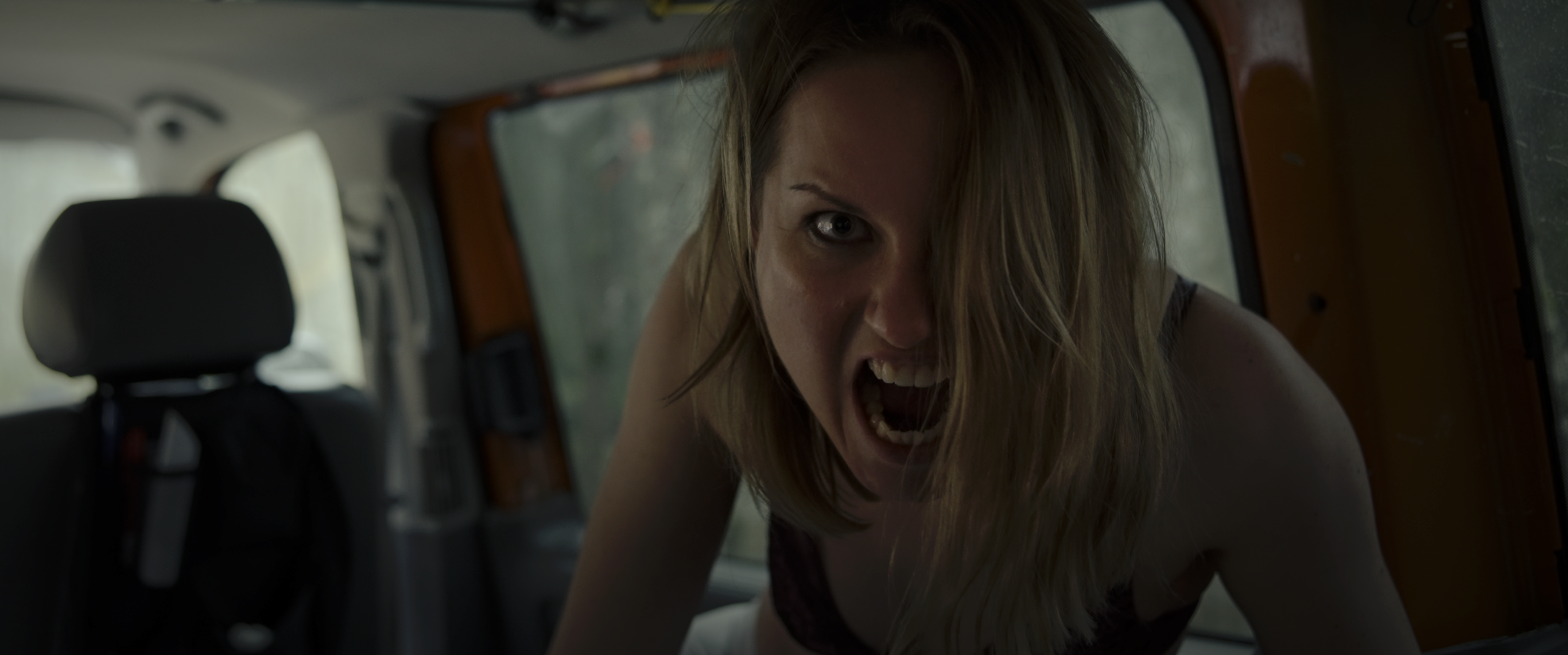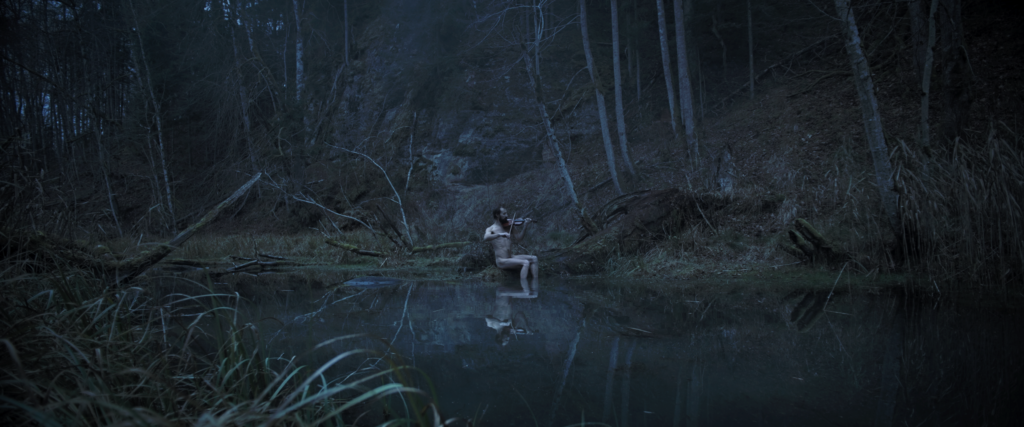
Upurga, Latvian director Ugis Olte’s first narrative full-length feature, skillfully blends elements from half a dozen iconic genre movies of the past decade. However, thanks to great writing, an ear for authentic dialogue, and a willingness to commit to fully-weird detours, it also comes across as one of the most original creations you’ll come into contact with at this year’s Fantaspoa Film Festival in Porto Alegre.
Using slasher humor and folk horror elements, Olte introduces us to Andrejs, a rafting instructor who invites himself to his sister Mara’s marketing shoot, which is to take place near a wild river (one perhaps inspired by the notorious, real-life Devil Lake). Mara’s boyfriend and the cameraman don’t take their job too seriously (it’s a product ad for veggie sausages), and the only one focusing on quality is producer Eva. Meanwhile, there’s unfriendly Inspector Salins, who insists they don’t cross the river and that they leave immediately, comes across as the person typically encountered at a gas shop along the way to the destination in horror movies from the past decade.

Andrejs is a likable protagonist from the start, extremely concerned with safety procedures and protective clothing, while everyone is poking fun at him for being uptight. There are traces of trauma due to Andrejs indirectly being the cause of one girl’s death by drowning, in a more than weird manner: because he didn’t let her go of her hand, she drowned in the end. If he had, she might’ve lived. In spite of what happened, Andrejs still wants to play the hero, and probably thinks that being prepared can prevent other misfortunes.
Ugis Olte injects a lot of humor into the movie – it is, after all, a trek in the wild, both through a rich forest and across a large river. Lines like “you have to p**s with respect here” are used as a tool for foreshadowing, because the director also points out the many ways in which nature can kill you: when a few of the characters find some mutated orchids and consume them, their behavior suddenly starts to change. Lost in euphoria, they wander around until feelings of lust consume them. If they’re unable to obtain their pleasure, they become aggressive, like wild animals. And they tend to run around naked a lot. After Andrejs has a tryst with Eva, who had just eaten one of the flowers, she growls at him and he wakes up abandoned in a muddy ditch. This is the point where the movie really doubles down on its weird vibe, adding in a lot of characters and becoming a mythological thriller in its own right.
By now, the reader who is familiar with the movie Nina In The Woods might have perhaps recognized the similar premise – an indie, genre-defying film which heavily resembles Upurga, one which fell below the radar but received some critical acclaim. However, there are elements from more recognizable movies at play too: the trippy river sequences which depict two drowned specters and show Anderjs struggling to reach the surface remind us of the techniques used by Kristina Buozyte in her Vanishing Waves. Although it seems similar to last year’s eco-horror Gaia, its blend of humor, weirdness, and shamanism make it closer to Sebastian Leilo’s Magic Magic. Another movie that has dealt with people apparently drowning and coming back to a different reality was Fredy Torres’s The Bell (La Campana). Lastly, Andrejs won’t manage to get over his trauma until he comes face to face with the result of his actions, and he might be obsessed with more than safety, just like the protagonist of For Those In Peril.
The major events in Upurga seem to be related to the biotope comprised of the lake and the area around it. The land enters a cyclical state of conversion, which the locals know about and warn each other about when it happens through the use of flares. One such flare in mid-air, giving off a red hue, is just one example of Upurga‘s assured visual style. Grey skies, troubled creeks, the moon reflected in the water’s surface, and upside-down foggy views depicting inner turmoil, all are used to establish the mood through creative camerawork and sullen cinematography. The movie achieves consistency across the board when it comes to its visuals, due to innovative camera angles and long shots, and even though the color palette is desaturated, the film doesn’t look cheap in the slightest. There are still colors being used in all the right places, such as with the yellow raincoats or the red boots Mara wears. Upurga also benefits from stunning sound design – creaks in the forest, the warped sounds of Andrejs’s visions, the sound is a constant reminder that something primal is driving the events of the film.

Survival, obsession, and acid trips, as well as the hardships caused by living near a seemingly magical river, are the main themes of Upurga. Past and present intertwine and people who disappeared near the river come back as muted shadows of their former selves, driven to do only one thing and do it well, whether it’s playing the violin or becoming a forest shaman. There is the very real possibility that you’ll either drown if you come into contact with it, or the river will fill you up with knowledge. The orchids might be a by-product, a small taste of the river’s power.
Modern life is slowly creeping in: there are reality-show references, poachers with parkour skills who speak a language of their own making. The mutation might be everywhere, and nearby local businesses aren’t shy about making a buck off the backs of naive tourists or even robbing them. But the locals are also fair, in their own way: as Andrejs was trying to save the girl who drowned years ago, they had warned him that he should just let her go as it was happening, but he didn’t understand why he should, perhaps because it seemed a nonsensical thing to do. The movie makes the case that the locals could have been right: the girl would have returned, albeit no longer the same person.
Andrejs tries to find the others with the help of the poachers, the sheriff, and the shaman, but he’s far from finding peace. The movie’s climax involves, in a rather surprising turn of events, a thirst for knowledge that is quenched (quite literally) in a dizzying Lynchian sequence involving past and present. The movie does create a tantalizing possibility with the introduction of two new characters, a violinist and his daughter, who – based strictly on the way she is framed, could either be Mara or, more likely, the drowned girl from his past, all with the help of some timey-wimey warping from having been in contact with the river. The movie expertly mixes elements of mystery, folk-horror, and “horror from the deep”, succeeding at keeping the viewer engaged for 80 minutes. It even briefly enters found-footage territory when Andrejs finds a video camera.
Depending on how the reader will interpret it, the ending, particularly the last shot, might ruin many of the threads left by the unanswered questions and even most of the river’s mystique. We can’t help but wonder if the movie could have been more effective by cutting those final moments altogether and leaving the viewer to make sense of it all. However, there are still just as many threads left hanging, and genre fans who are looking for a more unusual mix of styles should look no further. Upurga is an assured debut for a director who is bound for bigger and better things, and a perfect choice for the Fantaspoa Film Festival, one which showcases such films from around the world.
We watched Upurga as Part of the 2022 Fantaspoa Film Festival


More Film Reviews
If childhood memories could be distilled into pure energy, they would probably seem as radioactive as the golden glow emitted from the spray-painted wheat fields of The Reflecting Skin. Otherworldly,… George Carlin has a great routine about the nature of prayer. It can’t be done justice here, though it does arrive at the conclusion that God must have an awful… Some movies are so bad that they’re fun, like an 80s slasher flick with gratuitous gore and cheesy tropes. You know, the type of films that are so bad that… Dagr (2024), by director Matthew Butler-Hart and produced by Fizz & Ginger Films, is the perfect found footage film: a labour of love from a small but incredibly talented creative… From the dawn of humanity’s time on this Earth, fear has been the most important feeling for the survival of man. It is what keeps us alive, the reason… Co-Author Lisa Lebel Diana Toucedo’s Thirty Souls casts a gaze on an isolated, slowly dissolving community in Galicia where “life doesn’t end, but rather becomes something else.” This is due…The Reflecting Skin (1990): A Brief Examination of Vampires (and Other Bad Things) in Broad Daylight
The Righteous Film Review: Fantasia Festival 2021
Your Host (2025) Film Review – Come for the Shock Value, Stay for the Social Relevance? [FrightFest 2025]
Dagr (2024) Film Review – Found Footage Folk Horror That Slaps
Celebrating The Best Hidden Gems of The Found Footage Horror Genre (Part 1)
Thirty Souls Movie Review (2018) – Stages of Death


![Your Host (2025) Film Review – Come for the Shock Value, Stay for the Social Relevance? [FrightFest 2025]](https://www.grimoireofhorror.com/wp-content/uploads/2025/09/Your-Host-2025-cover-365x180.jpg)


